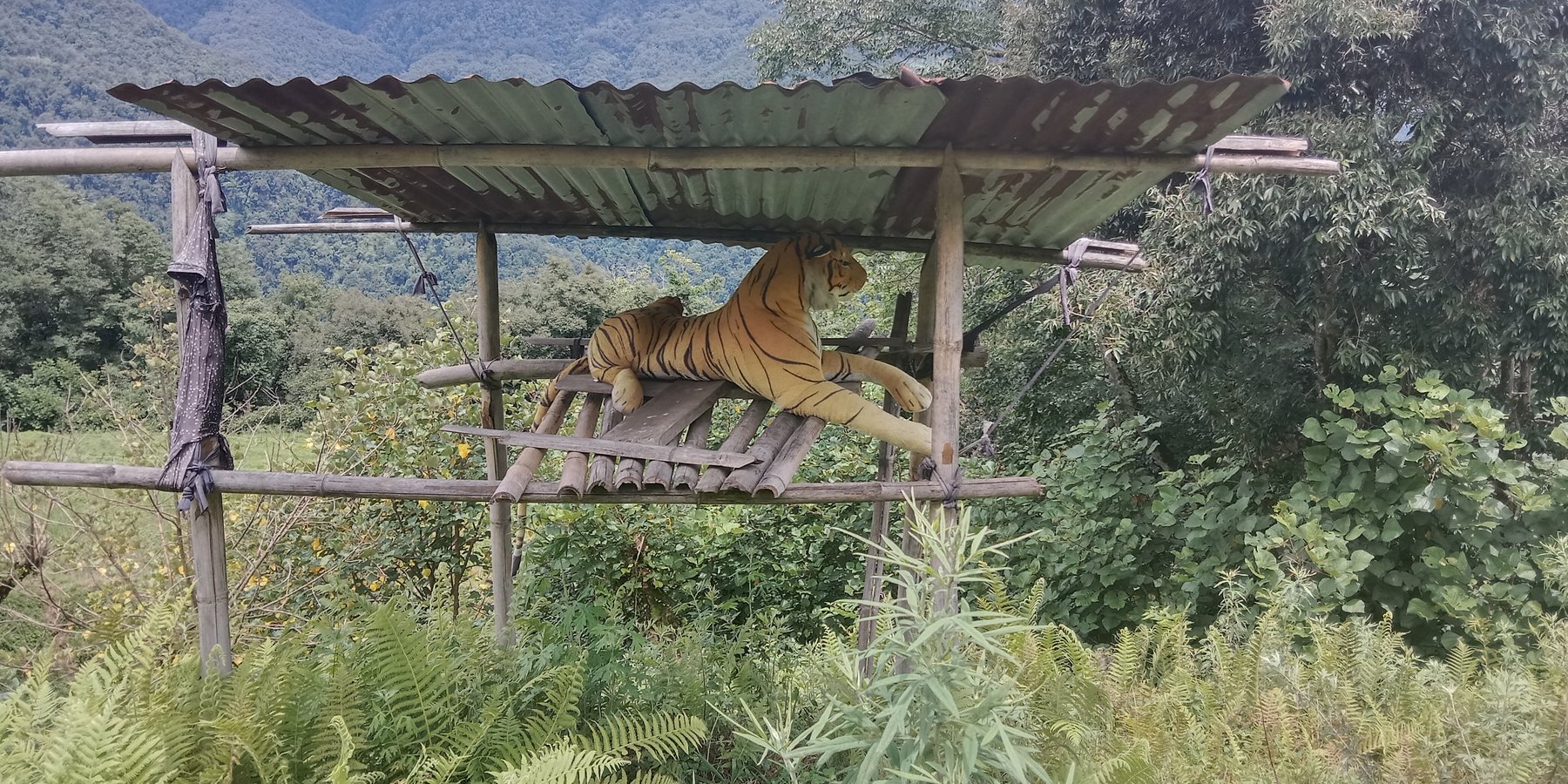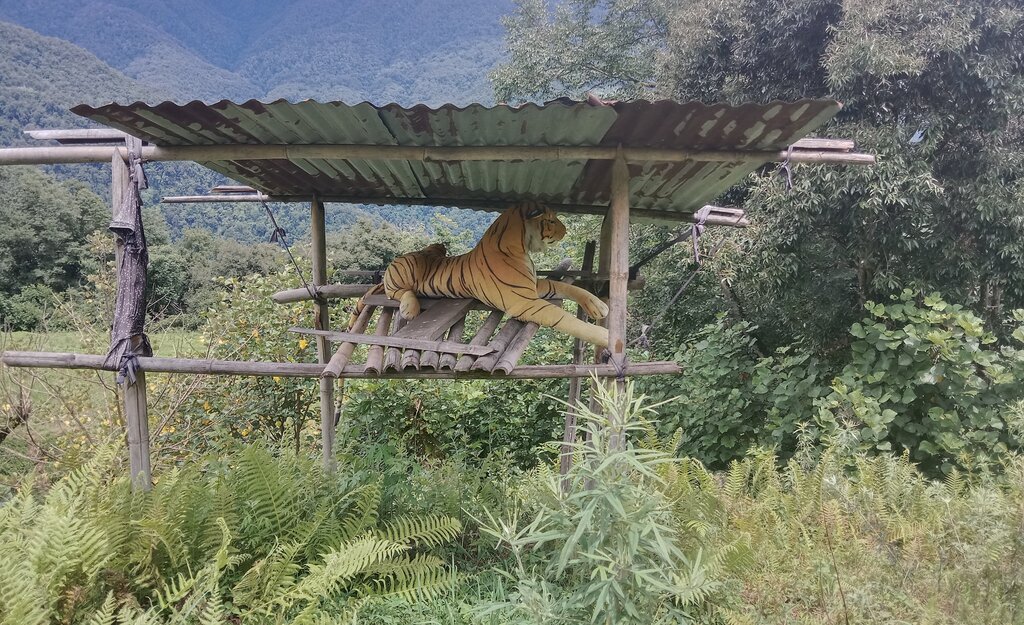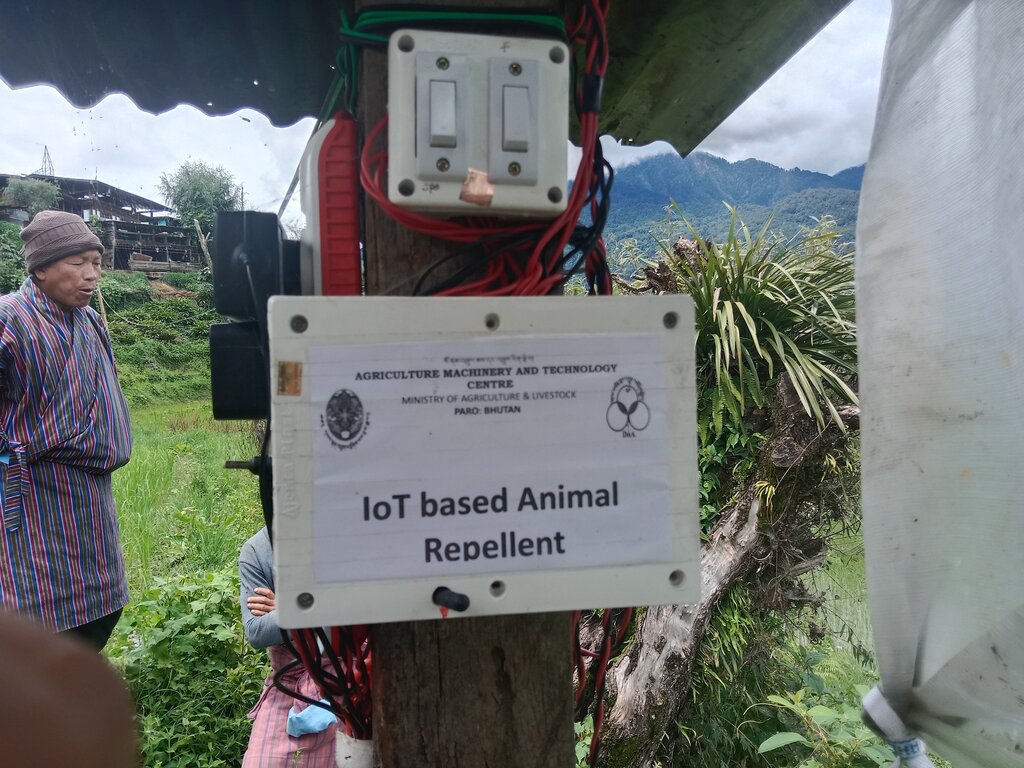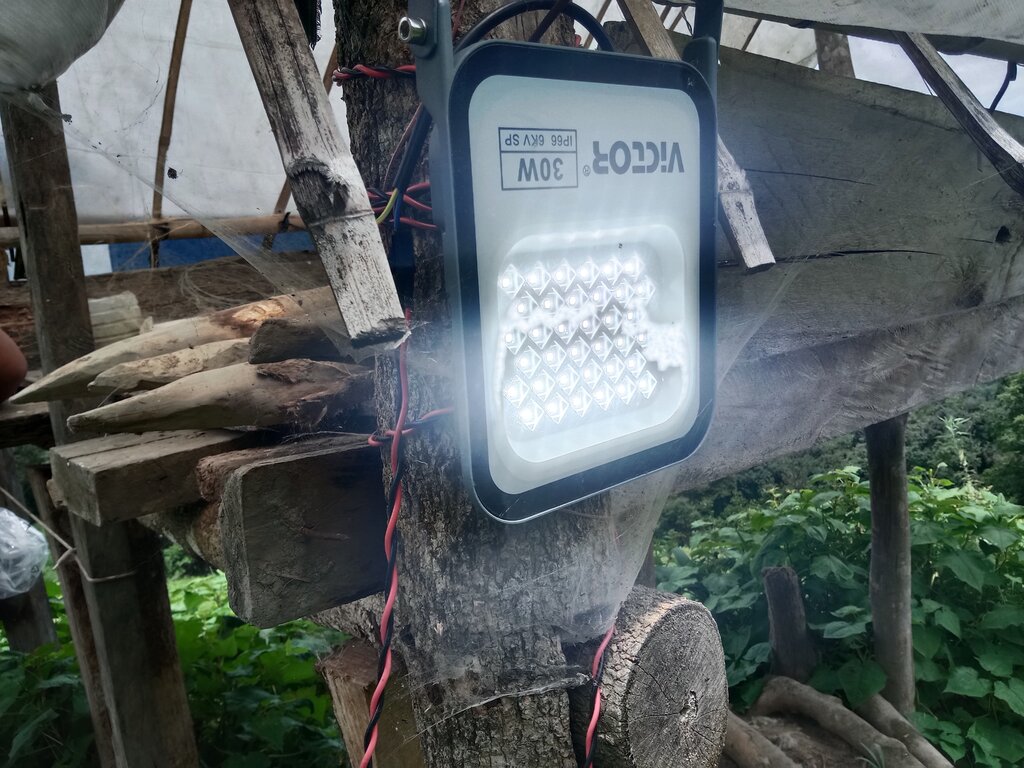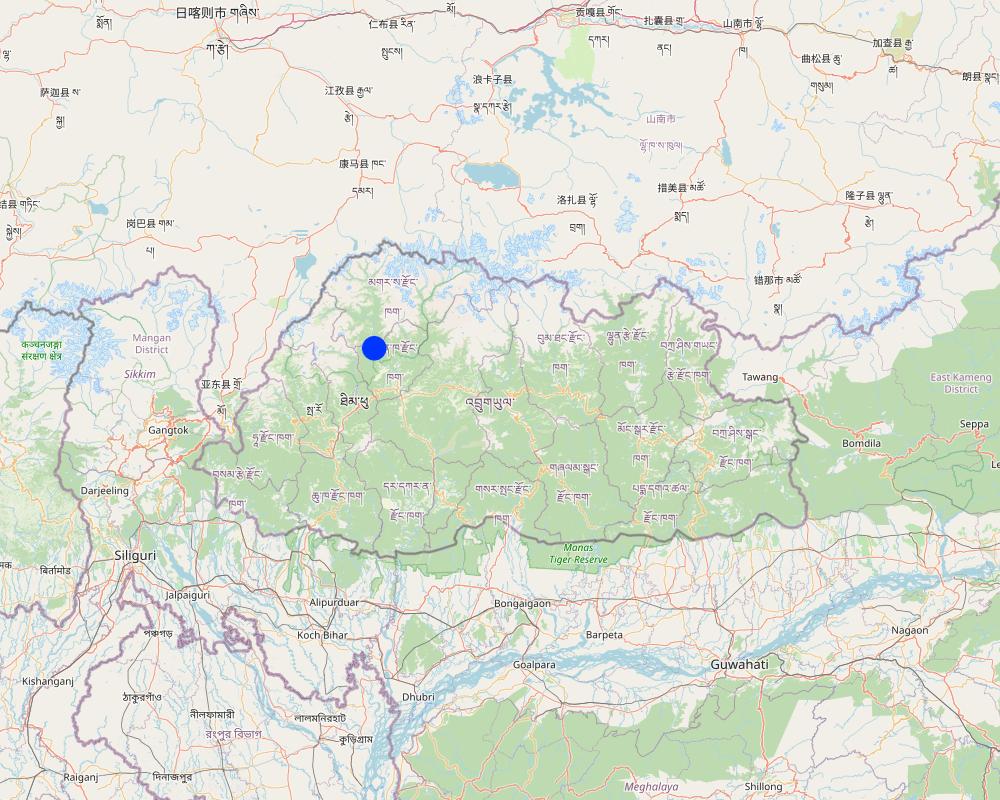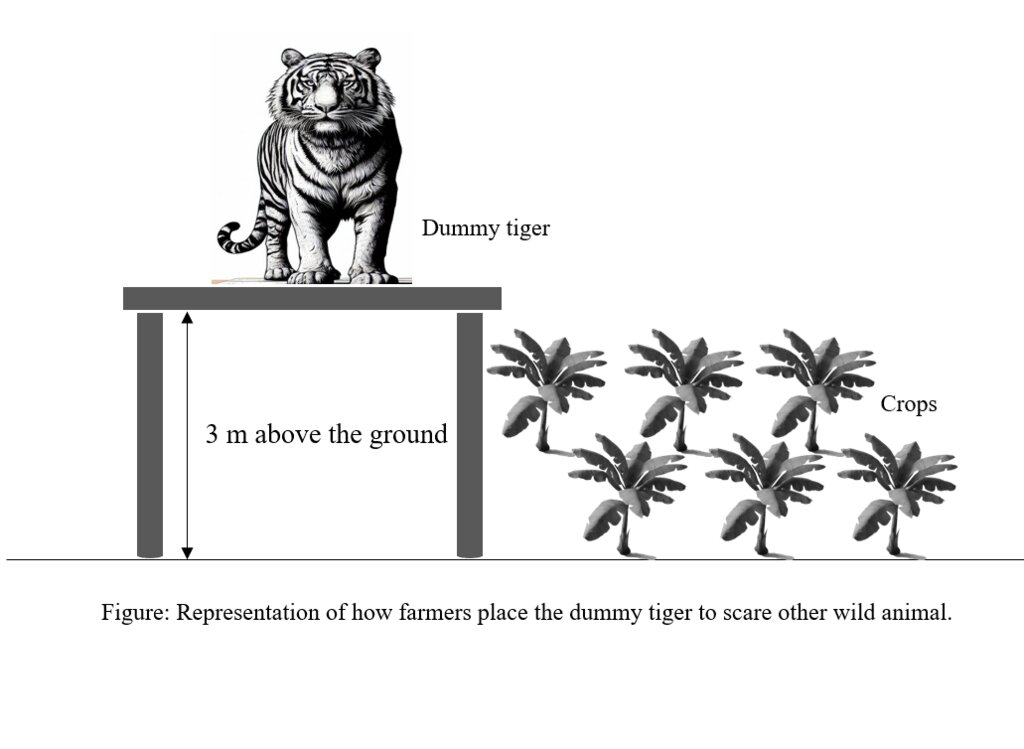Use of Dummy Tigers to Repel Wild Animals [Bután]
- Creación:
- Actualización:
- Compilador: Tshering Yangzom
- Editor: chenga Tshering
- Revisores: Rima Mekdaschi Studer, William Critchley, Joana Eichenberger
Tag Zuenma Laglen Thabtey Lothog Sungni (སྟག་རྫུན་མ་ལག་ལེན་འཐབ་སྟེ་ལོ་ཐོག་སྲུང་ནི།)
technologies_6860 - Bután
Visualizar secciones
Expandir todo Colapsar todos1. Información general
1.2 Detalles de contacto de las personas de referencia e instituciones involucradas en la evaluación y la documentación de la Tecnología
Persona(s) de referencia clave
usuario de la tierra:
Tshering
Drochukha Chiwog (Community), Goenshari Gewog (Block), Punakha Dzongkhag (District)
Bután
usuario de la tierra:
Tshering Kinley
Drochukha Chiwog (Community), Goenshari Gewog (Block), Punakha Dzongkhag (District)
Bután
usuario de la tierra:
Dorji Kinzang
Drochukha Chiwog (Community), Goenshari Gewog (Block), Punakha Dzongkhag (District)
Bután
usuario de la tierra:
Tenzin Namgay
Drochukha Chiwog (Community), Goenshari Gewog (Block), Punakha Dzongkhag (District)
Bután
usuario de la tierra:
Kinzang
Drochukha Chiwog (Community), Goenshari Gewog (Block), Punakha Dzongkhag (District)
Bután
usuario de la tierra:
Tshering Gyeltshen
Drochukha Chiwog (Community), Goenshari Gewog (Block), Punakha Dzongkhag (District)
Bután
usuario de la tierra:
Lhamo Dorji
Drochukha Chiwog (Community), Goenshari Gewog (Block), Punakha Dzongkhag (District)
Bután
Especialista MST:
Gyeltshen Tshewang
Gewog Agriculture Office, Goenshari Gewog (Block), Punakha Dzongkhag (District)
Bután
Nombre del proyecto que financió la documentación/ evaluación de la Tecnología (si fuera relevante)
Strengthening national-level institutional and professional capacities of country Parties towards enhanced UNCCD monitoring and reporting – GEF 7 EA Umbrella II (GEF 7 UNCCD Enabling Activities_Umbrella II)Nombre de la(s) institución(es) que facilitaron la documentación/ evaluación de la Tecnología (si fuera relevante)
National Soil Services Center, Department of Agric (National Soil Services Center, Department of Agric) - Bután1.3 Condiciones referidas al uso de datos documentados mediante WOCAT
El compilador y la/s persona(s) de referencia claves aceptan las condiciones acerca del uso de los datos documentados mediante WOCAT:
Sí
1.4 Declaración de la sostenibilidad de la Tecnología descrita
¿La Tecnología aquí descrita resulta problemática en relación a la degradación de la tierra, de tal forma que no puede considerársela una tecnología sostenible para el manejo de la tierra?
No
Comentarios:
As per the responses, the use of a dummy tiger in guarding crops do not seem to have having direct role in mitigating land degradation. However, it can be claimed as a part of SLM technologies because it protects the crops from wild animals. Standing crops in the field is important to prevent erosion (both soil and water), add nitrogen to the soil (e.g., by leguminous crops), and for nutrient cycling. Also, the use of toy tiger prevents the land user from resorting to fatal methods of crop guarding that necessitates the killing of wildlife.
2. Descripción de la Tecnología MST
2.1 Breve descripción de la Tecnología
Definición de la Tecnología:
Dummy tigers are used to scare off crop predators. This can be considered a SLM technology because it protects the crops from wild animals which in turn prevents erosion (both soil and water), adds nitrogen to the soil (i.e., by leguminous crops), and helps in nutrient cycling. Furthermore, time is freed up for the farmer to carry out other SLM activities.
2.2 Descripción detallada de la Tecnología
Descripción:
In the region of Drochukha, Bhutan, the foremost challenge faced by rural communities is crops damage by wildlife. Land users in this area contend with damage inflicted by a variety of wild animals, including wild boar, barking deer, sambar deer, monkeys, porcupines, bears, and rats. To mitigate crop damage by wildlife, the land users of Drochukha have implemented a unique solution by strategically placing dummy tigers to deter these animals and safeguard their crops.
In 2018, a woman from Drochukha initiated the idea of using dummy tigers to protect crops, and it proved to be highly successful. Following this, other residents also adopted the practice. Farmlands situated near the forest's periphery experience the most significant crop damage by wild animals. By placing dummy tigers near the forest's edge, the land users have not only reduced wildlife attacks in the peripheral regions but also significantly decreased such incidents in the central areas. To protect their crops from wild animals, they procured a dummy tiger at a cost of Nu. 3,380 (about USD 40) from Bajo town in Wangduephodrang Dzongkhag and another dummy tiger costing Nu. 2,000 (about USD 25) from the Indian market in Jaigaon. The land users constructed a raised wooden platform by placing four wooden poles in the ground and adding planks over them to support the dummy tigers, ensuring that they faced the forest.
The implementation of dummy tigers (two) has yielded numerous benefits for 21 households in the region. With the adoption of this innovative approach, Drochukha farmers have been able to increase their crop production and rejuvenate previously unused lands. Dummy tigers effectively safeguard standing crops and prevent wildlife depredation. Maintaining standing crops in the fields is essential to prevent erosion, both of soil and water, while also contributing nitrogen to the soil through the cultivation of leguminous crops and facilitating nutrient cycling. An important aspect of employing dummy tigers is that it prevents land users from resorting to fatal methods of crop protection that may involve the killing of wildlife. Human-wildlife conflicts have thus been reduced. The primary current concern of the land users of Drochukha is the fading colour of the dummy tigers, and they are eager for improved interventions that may involve mobile and sound-producing tigers.
The Agriculture Machinery Centre (AMC) and the Dzongkhag Agriculture Office (DAO) have joined forces to create an IoT-based animal-repellent system. This system, positioned at the field's periphery, comprises three primary components: a speaker, a receptor card, and an amplifier. Once connected to an owner's smartphone, the system allows for the remote playback of various animal sounds. One system, consisting of a single receptor card, can be linked to up to five users. Additionally, two LED flashlights are integrated into the system to deter wild boars at night through powerful pulse flashes. The complete system comes at a cost of Nu. 30,000. Moreover, in their most recent endeavors, AMC and DAO are currently developing a robotic tiger capable of moving its head and limbs, enabling it to patrol the guardhouse and serve as a further deterrent to wildlife. The technology is being piloted as a project to evaluate its effectiveness in the field through trials.
2.3 Fotografías de la Tecnología
Comentarios generales sobre las fotos:
The IoT-based animal-repellent system is one of the promising technologies that evolved with the need to guard the field in the absence of humans.
2.5 País/ región/ lugares donde la Tecnología fue aplicada y que se hallan comprendidos por esta evaluación
País:
Bután
Región/ Estado/ Provincia:
Drochukha Chiwog, Goenshari Gewog, Punakha Dzongkhag
Especifique la difusión de la Tecnología:
- aplicada en puntos específicos/ concentrada en un área pequeña
¿El/los sitio(s) de la Tecnología se ubica(n) en un área de protección permanente?
Sí
Si fuera el caso, especifique :
The area falls under Jigme Dorji National Park (JDNP). The park is one of the oldest protected areas in Bhutan. Endowed with a high number of endangered plants and animals supported by a huge range of vegetation types and climatic regimes, JDNP is undoubtedly the conservation jewel in the Eastern Himalayas. It is also the treasure trove of medicinal plants, natural hot springs, medicinal waters, and jaw-dropping sceneries, unparalleled in the country.
Map
×2.6 Fecha de la implementación
Indique año de implementación:
2018
2.7 Introducción de la Tecnología
Especifique cómo se introdujo la Tecnología:
- mediante la innovación de usuarios de tierras
Comentarios (tipo de proyecto, etc.):
A lady named Dorji Lhamo of the community, originally from Mongar (Eastern Bhutan) has seen some tiger toys placed at the field peripheries to scare away the wild animals while making her visit to her native village. With much curiosity, she tried doing the same thing in Drochukha (Western Bhutan) where she currently lives. It worked, especially in scaring monkeys away.
3. Clasificación de la Tecnología MST
3.1 Propósito(s) principal(es) de la Tecnología MST
- mejorar la producción
- conservar el ecosistema
- crear impacto económico benéfico
- crear impacto social benéfico
3.2 Tipo(s) actuales de uso de la tierra donde se aplica la Tecnología
Mezcla de tipos de uso de tierras dentro de la misma unidad de tierras: :
Sí
Especifique el uso combinado de tierras (cultivos/ pastoreo/ árboles):
- Agroforestería

Tierras cultivadas
- Cosecha anual
- Cultivos perennes (no leñosos)
- Cosecha de árboles y arbustos
Cosechas anuales - Especifique cultivos:
- cereales - cebada
- cereales - maíz
- cereales - arroz (humedal)
- cereales - trigo (invierno)
Cultivos perennes (no maderables) - Especifique cultivos:
- banana/plátano/abacá
- herbs, chili, capsicum
Cultivos de matorrales y arbustos - Especifique cultivos:
- avocado
- cítricos
Número de temporadas de cultivo por año:
- 1
¿Se practica el intercultivo?
Sí
Si respondió que sí, especifique qué cultivos son intercultivados:
Vegetables are intercropped.
¿Se practica la rotación de cultivos?
Sí
Si fuera el caso, especifique :
Vegetables are rotated.

Bosques
- Bosques/ zonas boscosas (semi) naturales
Bosques/ zonas boscosas (semi-) naturales: Especifique tipo de manejo:
- Tala selectiva
- Uso de productos forestales no madereros
¿Los árboles especificados son deciduos o imperecederos?
- mixto deciduo/ imperecedero
Productos y servicios:
- Madera
- Leña
- Otros productos forestales
3.3 ¿Cambió el uso de tierras debido a la implementación de la Tecnología?
¿Cambió el uso de tierras debido a la implementación de la Tecnología?
- No (Continúe con la pregunta 3.4)
3.4 Provisión de agua
Provisión de agua para la tierra donde se aplica la Tecnología:
- mixta de secano – irrigada
Comentarios:
The community has two irrigation sources, Khaow Lum benefiting 6 households, and Jaga Lum benefiting all 21 households.
3.5 Grupo MST al que pertenece la Tecnología
- Human-wildlife conflict management
3.6 Medidas MST que componen la Tecnología

medidas estructurales
- S11: Otros
Comentarios:
This SLM technology would fall under the structure category as it requires a simple structural wooden stand to place the tiger toys.
3.7 Principales tipos de degradación de la tierra encarados con la Tecnología

erosión de suelos por agua
- Wt: pérdida de capa arable/ erosión de la superficie

erosión de suelos por viento
- Et: pérdida de capa arable

degradación biológica
- Bc: reducción de la cobertura vegetal del suelo
Comentarios:
Based on the responses, it appears that the utilization of toy tiger decoys for crop protection may not be directly associated with mitigating land degradation. Nevertheless, it can be considered a component of Sustainable Land Management (SLM) technologies since it serves to safeguard crops from wildlife damage. Preserving standing crops in fields holds significance in preventing erosion, both in terms of soil and water. Furthermore, standing crops contribute to soil enrichment by introducing nitrogen (e.g., through leguminous crops) and facilitate nutrient cycling. Another crucial aspect is that the toy tigers effectively deter wildlife from preying on crops, and they also aid in repelling vertebrate pests from fields.
3.8 Prevención, reducción o restauración de la degradación de la tierra
Especifique la meta de la Tecnología con relación a la degradación de la tierra:
- prevenir la degradación de la tierra
- reducir la degradación de la tierra
Comentarios:
Based on the responses, it seems that the use of toy tigers may not directly address land degradation. However, it can be categorized as a component of Sustainable Land Management (SLM) technologies because it plays a role in protecting crops from wildlife damage. Maintaining standing crops in fields is essential for erosion prevention, both in terms of soil and water conservation. Additionally, it contributes to soil enrichment by introducing nitrogen, especially through the cultivation of leguminous crops, and supports nutrient cycling. Another significant aspect is that toy tigers effectively serve as a deterrent against wildlife crop depredation and help in repelling vertebrate pests from fields
4. Especificaciones técnicas, actividades de implementación, insumos y costos
4.1 Dibujo técnico de la Tecnología
Especificaciones técnicas (relacionadas al dibujo técnico):
The tiger toys are placed 3 meters above the ground. To ensure stability, the toys are placed on the planks supported by strong poles.
Autor:
Ongpo Lepcha
Fecha:
11/12/2023
4.2 Información general sobre el cálculo de insumos y costos
Especifique cómo se calcularon los costos e insumos:
- por unidad de Tecnología
otra / moneda nacional (especifique):
Nu.
Si fuera relevante, indique la tasa de cambio de dólares americanos a la moneda local (ej. 1 U$ = 79.9 Reales Brasileros): 1 U$ =:
80,0
Indique el costo promedio del salario de trabajo contratado por día:
800
4.3 Actividades de establecimiento
| Actividad | Momento (estación) | |
|---|---|---|
| 1. | Procurement of tiger toys. | Before cropping season |
| 2. | Construction of guard houses using any available materials to place the tiger toys. | Before cropping season |
| 3. | Placing the tiger toys. | Cropping season |
Comentarios:
The need for repainting the faded colours and the lack of movement of the tiger toys are the shortcomings associated with this technology.
4.4 Costos e insumos necesarios para el establecimiento
| Especifique insumo | Unidad | Cantidad | Costos por unidad | Costos totales por insumo | % de los costos cubiertos por los usuarios de las tierras | |
|---|---|---|---|---|---|---|
| Mano de obra | Labor | man/day | 1,0 | 800,0 | 800,0 | 100,0 |
| Otros | Tiger toy | No. | 1,0 | 3380,0 | 3380,0 | 100,0 |
| Otros | Tiger toy | No. | 1,0 | 2000,0 | 2000,0 | 100,0 |
| Costos totales para establecer la Tecnología | 6180,0 | |||||
| Costos totales para establecer la Tecnología en USD | 77,25 | |||||
Comentarios:
The current costing is being done based on the local market value of tiger toys. As per the respondents, the tiger toy of the required size cost Nu. 3380 from the local market (Wangdi Phodrang), whereas the same tiger cost Nu. 2000 from the Indian (Jaigoan) market.
4.5 Actividades de establecimiento/ recurrentes
Comentarios:
Since the adoption began in 2018, no maintenance, including the replacement of tiger toys, has been necessary. However, in the upcoming years, maintenance may become necessary due to the fading color of the tiger toys.
4.6 Costos e insumos necesarios para actividades de mantenimiento/ recurrentes (por año)
Si no puede desglosar los costos especificados en la tabla anterior, proporcione un estimado de los cálculos totales en los que se incurrió para mantener la Tecnología:
5346,0
Comentarios:
Buying two new dummy tigers as replacements would cost approximately 66 USD (Nu. 5346) on the higher pricing end and around 50 USD (Nu. 4050) on the lower pricing end.
5. Entorno natural y humano
5.1 Clima
Lluvia anual
- < 250 mm
- 251-500 mm
- 501-750 mm
- 751-1,000 mm
- 1,001-1,500 mm
- 1,501-2,000 mm
- 2,001-3,000 mm
- 3,001-4,000 mm
- > 4,000 mm
Zona agroclimática
- semi-árida
Dry sub tropical
5.2 Topografía
Pendientes en promedio:
- plana (0-2 %)
- ligera (3-5%)
- moderada (6-10%)
- ondulada (11-15%)
- accidentada (16-30%)
- empinada (31-60%)
- muy empinada (>60%)
Formaciones telúricas:
- meseta/ planicies
- cordilleras
- laderas montañosas
- laderas de cerro
- pies de monte
- fondo del valle
Zona altitudinal:
- 0-100 m s.n.m.
- 101-500 m s.n.m.
- 501-1,000 m s.n.m
- 1,001-1,500 m s.n.m
- 1,501-2,000 m s.n.m
- 2,001-2,500 m s.n.m
- 2,501-3,000 m s.n.m
- 3,001-4,000 m s.n.m
- > 4,000 m s.n.m
Indique si la Tecnología se aplica específicamente en:
- no relevante
5.3 Suelos
Profundidad promedio del suelo:
- muy superficial (0-20 cm)
- superficial (21-50 cm)
- moderadamente profunda (51-80 cm)
- profunda (81-120 cm)
- muy profunda (>120 cm)
Textura del suelo (capa arable):
- áspera/ ligera (arenosa)
- mediana (limosa)
Textura del suelo (> 20 cm debajo de la superficie):
- áspera/ ligera (arenosa)
- mediana (limosa)
Materia orgánica de capa arable:
- elevada (>3%)
Si se halla disponible, adjunte una descripción completa de los suelos o especifique la información disponible, por ej., tipo de suelo, pH/ acidez de suelo, capacidad de intercambio catiónico, nitrógeno, salinidad, etc. :
Moisture content-3.10%
Organic matter-7.08 %
Organic carbon-4.12%
pH-6.35
Electrical conductivity-181.33 µs/cm
Nitrogen-0.21
Phosphorus-0.21
Potassium-81.90 mg/100ml
Soil texture-Loamy sand
5.4 Disponibilidad y calidad de agua
Agua subterránea:
5-50 m
Disponibilidad de aguas superficiales:
bueno
Calidad de agua (sin tratar):
agua potable de buena calidad
La calidad de agua se refiere a:
agua superficial
¿La salinidad del agua es un problema?
No
¿Se está llevando a cabo la inundación del área? :
No
Comentarios y especificaciones adicionales sobre calidad y cantidad de agua:
A landslide in the community was recorded in 1991, losing about one acre of land.
5.5 Biodiversidad
Diversidad de especies:
- elevada
Diversidad de hábitats:
- elevada
Comentarios y especificaciones adicionales sobre biodiversidad:
The greater vegetation coverage at the outskirts of the community indicates a higher level of habitat and species biodiversity.
5.6 Las características de los usuarios de la tierra que aplican la Tecnología
Sedentario o nómada:
- Sedentario
Orientación del mercado del sistema de producción:
- mixta (subsistencia/ comercial)
Ingresos no agrarios:
- 10-50% de todo el ingreso
Nivel relativo de riqueza:
- promedio
Individuos o grupos:
- individual/ doméstico
Nivel de mecanización:
- trabajo manual
- mecanizado/motorizado
Género:
- mujeres
- hombres
Edad de los usuarios de la tierra:
- jóvenes
- personas de mediana edad
Indique otras características relevantes de los usuarios de las tierras:
The Drochukha community came into existence after their ancestors migrated to the current site from Gasa Dzongkhag some 50 years ago. Only 2 of 21 households are native.
5.7 Área promedio de la tierra usada por usuarios de tierra que aplican la Tecnología
- < 0.5 ha
- 0.5-1 ha
- 1-2 ha
- 2-5 ha
- 5-15 ha
- 15-50 ha
- 50-100 ha
- 100-500 ha
- 500-1,000 ha
- 1,000-10,000 ha
- > 10,000 ha
¿Esto se considera de pequeña, mediana o gran escala (refiriéndose al contexto local)?
- escala mediana
Comentarios:
The land holdings of the household in the community range from 1 - 5 acres, a mix of small-scale and large-scale as per the local context. The average land holding at the national level is 3 acres (1.2 ha)
In the local context:
3 acres (1.2 ha) = medium scale
> 3 acres = large-scale
<3 acres = small-scale
5.8 Tenencia de tierra, uso de tierra y derechos de uso de agua
- Family land
Derechos de uso de tierra:
- individual
Derechos de uso de agua:
- comunitarios (organizado)
- individual
¿Los derechos del uso de la tierra se basan en un sistema legal tradicional?
Sí
Especifique:
The land use rights in Bhutan is based on a traditional legal system guided by formal land act and land rules and regulations.
5.9 Acceso a servicios e infraestructura
salud:
- pobre
- moderado
- bueno
educación:
- pobre
- moderado
- bueno
asistencia técnica:
- pobre
- moderado
- bueno
empleo (ej. fuera de la granja):
- pobre
- moderado
- bueno
mercados:
- pobre
- moderado
- bueno
energía:
- pobre
- moderado
- bueno
caminos y transporte:
- pobre
- moderado
- bueno
agua potable y saneamiento:
- pobre
- moderado
- bueno
servicios financieros:
- pobre
- moderado
- bueno
6. Impactos y comentarios para concluir
6.1 Impactos in situ demostrados por la Tecnología
Impactos socioeconómicos
Producción
producción de cultivo
Cantidad antes de MST:
125kg
Cantidad luego de MST:
250kg
Comentarios/ especifique:
Previously, farmers could only harvest approximately 125 kg of potatoes when planting 250 kg of seeds. Now, they can harvest nearly 1500 kg of potatoes from the same amount of seeds.
Ingreso y costos
gastos en insumos agrícolas
Comentarios/ especifique:
Daytime crop guarding against monkeys is no longer necessary, allowing land users to allocate their time to other productive activities.
ingreso agrario
Comentarios/ especifique:
With no need for daytime crop guarding, land users can engage in off-farm activities, earning up to Nu. 800 per day. This has proven to be advantageous in increasing their overall farm income.
diversidad de fuentes de ingreso
Comentarios/ especifique:
Off-farm earning has become possible. Production and marketing of other seasonal crops and high-value crops are possible.
carga de trabajo
Comentarios/ especifique:
The continuous daytime guarding is not required anymore.
Impactos socioculturales
seguridad alimentaria/ autosuficiencia
Comentarios/ especifique:
The land users can produce enough for self-consumption and commercialization.
oportunidades culturales
Comentarios/ especifique:
The use of lethal methods for crop protection is no longer necessary, thus preventing the killing of wild animals
Impactos ecológicos
Biodiversidad: vegetación, animales
control de pestes/ enfermedades
Comentarios/ especifique:
The control of vertebrate pests, especially monkeys, has been very successful.
6.2 Impactos fuera del sitio demostrados por la Tecnología
Protection of farms further from the land users' farms
Comentarios/ especifique:
Toy tigers protect farms further from the land users' farms also. There is no intrusion of wild animals into the villages.
6.3 Exposición y sensibilidad de la Tecnología al cambio climático gradual y a extremos relacionados al clima/ desastres (desde la percepción de los usuarios de tierras)
Cambio climático gradual
Cambio climático gradual
| Estación | Incremento o reducción | ¿Cómo es que la tecnología soporta esto? | |
|---|---|---|---|
| temperatura anual | incrementó | muy bien | |
| lluvia anual | incrementó | muy bien |
Extremos (desastres) relacionados al clima
Desastres climatológicos:
| ¿Cómo es que la tecnología soporta esto? | |
|---|---|
| tormenta de lluvia local | muy bien |
| tormenta local | muy bien |
| granizada local | muy bien |
| tormenta de viento | muy bien |
Desastres climatológicos
| ¿Cómo es que la tecnología soporta esto? | |
|---|---|
| condiciones extremas de invierno | muy bien |
Desastres biológicos
| ¿Cómo es que la tecnología soporta esto? | |
|---|---|
| enfermedades epidémicas | muy bien |
| insectos/ infestación de gusanos | muy bien |
6.4 Análisis costo-beneficio
¿Cómo se comparan los beneficios con los costos de establecimiento (desde la perspectiva de los usuarios de tierra)?
Ingresos a corto plazo:
muy positivo
Ingresos a largo plazo:
muy positivo
¿Cómo se comparan los beneficios con los costos de mantenimiento/ recurrentes (desde la perspectiva de los usuarios de tierra)?
Ingresos a corto plazo:
muy positivo
Ingresos a largo plazo:
muy positivo
Comentarios:
The technology is cost effective and every individual can afford it easily.
6.5 Adopción de la Tecnología
- 11-50%
Si tiene la información disponible, cuantifique (número de hogares y/o área cubierta):
Out of the 21 households, 10 have embraced the technology. The reason for this is primarily that the remaining 11 households have their lands situated in the central part of the community and do not share boundaries with the forests.
De todos quienes adoptaron la Tecnología, ¿cuántos lo hicieron espontáneamente, por ej. sin recibir nada de incentivos/ materiales:
- 91-100%
Comentarios:
The expenditures were borne by the farmers. No external funding was involved in buying tiger toys.
6.6 Adaptación
¿La tecnología fue modificada recientemente para adaptarse a las condiciones cambiantes?
Sí
otros (especifique):
Modern technology integration
Especifique la adaptación de la Tecnología (diseño, material/ especies, etc.):
The Agriculture Machinery Centre (AMC) and the Dzongkhag Agriculture Office (DAO) have joined forces to create an IoT-based animal-repellent system. This system, positioned at the field's periphery, comprises three primary components: a speaker, a receptor card, and an amplifier. Once connected to a owner's smartphone, the system allows for the remote playback of various animal sounds. One system, consisting of a single receptor card, can be linked to up to five users. Additionally, two LED flashlights are integrated into the system to deter wild boars at night through powerful pulse flashes. The complete system comes at a cost of Nu. 30,000.
Moreover, in their most recent endeavors, AMC and DAO are currently developing a robotic tiger capable of moving its head and limbs, enabling it to patrol the guardhouse and serve as a further deterrent to wildlife. The technology is being piloted as a project to evaluate its effectiveness in the field through trials.
6.7 Fuerzas/ ventajas/ oportunidades de la Tecnología
| Fuerzas/ ventajas/ oportunidades desde la perspectiva del usuario de la tierra |
|---|
| The crop production is enhanced. |
| Lethal methods for crop protection have been avoided. |
| Overall farm income is increased after the adoption of technology. |
| Fuerzas/ ventajas/ oportunidades desde la perspectiva del compilador o de otra persona de referencia clave |
|---|
| No major threats to the external environment and user friendly technology. |
| Tiger toy protects the crops from wild animals. Standing crops in the field is important to prevent erosion (both soil and water), add nitrogen to the soil (e.g., by leguminous crops), and for nutrient cycling. The other important aspect is toy tiger prevents wildlife depredation. |
6.8 Debilidades/ desventajas/ riesgos de la Tecnología y formas de sobreponerse a ellos
| Debilidades/ desventajas/ riesgos desde la perspectiva del usuario de la tierra | ¿Cómo sobreponerse a ellas? |
|---|---|
| The colour fading of tiger toys could be a problem in the future. | Repaint toy tigers. |
| Financial burden on the land users. | Implement a cost-sharing mechanism. |
| Debilidades/ desventajas/ riesgos desde la perspectiva del compilador o de otra persona de referencia clave | ¿Cómo sobreponerse a ellas? |
|---|---|
| The wild animals especially the monkeys might get used to tiger toys. | A robotic tiger producing sounds in certain intervals would be the next best innovation, which is already under process. |
7. Referencias y vínculos
7.1 Métodos/ fuentes de información
- visitas de campo, encuestas de campo
7
- entrevistas con usuarios de tierras
7
- entrevistas con especialistas/ expertos en MST
1
¿Cuándo se compilaron los datos (en el campo)?
18/07/2023
7.3 Vínculos a la información relevante disponible en línea
Título/ descripción:
Introduction – Jigme Dorji National Park
URL:
https://www.dofps.gov.bt/introduction-jigme-dorji-national-park/
Vínculos y módulos
Expandir todo Colapsar todosVínculos
No hay vínculos
Módulos
No se hallaron módulos


